推荐等级:
发布时间: 2022-03-19 10:23
扫码用手机做题
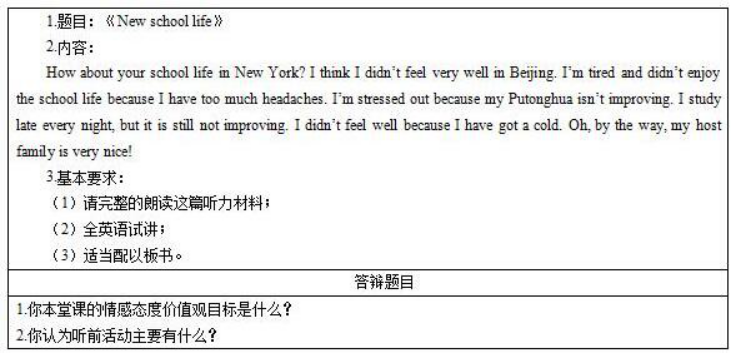
本题解析:
《New school life》主要教学过程及板书设计
教学过程
Step1 Warming-up and lead-in
After greeting the students, the teacher shows a segment of the film St, Trinian's, which is about some trouble-making students, and invite the students to have a free talk about their headaches in the new semester.
Step2 Pre-listening
The teacher tells the story of John, the speaker, who is a new comer of Beijing, and shows several pictures of John’s school life to teach the new phrases “have a headache”, “stress out” and “get a cold”.
Ask students to predict the reasons why John feels bad in Beijing, any presumptions are encouraged.
Step3 While-listening
1. Fast-listening
Get students to listen to the tape for a first time to get the main idea of the listening material and think over the following questions:
Question1: Did John enjoy his school life in Beijing?
Question2: Is John’s Putonghua improving?
Question3: How is John’s host family?
2. Careful-listening
答辩题目解析
1.你本堂课的情感态度价值观目标是什么?
【参考答案】
我本次设定的情感态度目标主要有如下两个:一是学生能锻炼主动克服学习过程中所遇困难的能力,二是学生能够进一步加深其对英语学习的兴趣及动机。
2.你认为听前活动主要有什么?
【参考答案】
听前活动的主要作用在于让学生对所学材料内容有所准备,因而,老师可以采用以下几种方式:
(1)介绍相关的背景知识,用图片或是视觉影响吸引学生对听力材料的注意力,激发学生的观察能力和描述能力;
(2)提供一些词汇或相关问题,让学生预测所要听的材料内容;
(3)提出一些开放性问题锻炼学生的想象能力和分析问题的能力。
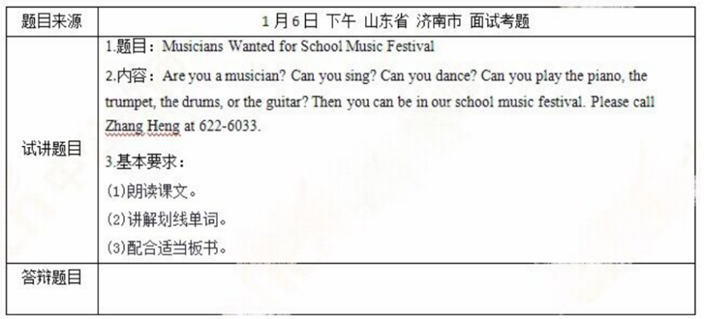
本题解析:
【教案】
Teaching aims:
Knowledge aim: Students will master the sentence pattern “can you” and some new words such as sing, play the piano and so on.
Ability aim: Students will improve their speaking ability through group work.
Emotional aim: Students will take part in the class actively and be fond of learning English.
Key and difficult point: Students can master the sentence pattern and words and can take part into the class actively.
Teaching procedure:
Step 1: Warming-up
Greeting: Good morning boys and girls, this is your beloved English teacher, Jessica. How are you today? Fine, I'm too. It is snowing right now right? The weather is getting colder and colder, so put on more clothes and don't catch cold ok? Otherwise you will lag behind for your English studying.
Lead-in: 展示有关音乐会的图片:Sydney Opera House/ National opera house in Beijing
1)what can you see in the pictures
2) Where can we do in it?
3) Do you like to enjoy a music show in our school?
4) Let’s take a look of today’s class: musicians wanted for school music festival.
Step 2: Pre-reading
图片讲解单词:sing/ dance/ play the piano/
1) What can you see in the pictures: 依次展示TF boys/ ballet/ 朗朗
2) What is he/ she doing in the picture? 依次引出: sing/ dance/ play the piano.
3) When you sing, you make musical sounds with your voice, usually producing words that fit a tune.
4) When you dance, you move your body and feet in a way that follows a rhythm, usually in time to music.
5) A piano is a large musical instrument with a row of black and white keys. When you press these keys with your fingers, little hammers hit wire strings inside the piano, which vibrate to produce musical notes.
Step 3: While-reading
设置阅读问题:
1) Which musical instruments are mentioned in the passage:
The piano (Y), the trumpet (Y), the drums (Y). violin (X).
2) who should you contact if you are interested: zhang heng
3) The telephone number? 622-6033.
Step4: Post-reading
1) Do a survey: which musical instruments can your classmate play?
2) Making a conversation by using the result of the survey: Do you want to go to the music festival?
Blackboard design:

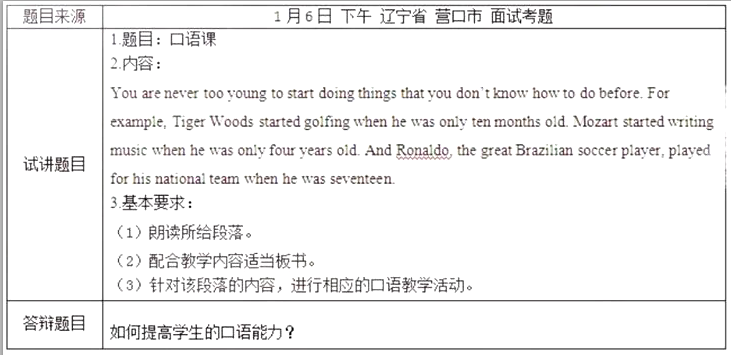
本题解析:
【教案】
Teaching aims:
Knowledge aim: students will know the topic of “you are never too young to start doing things that you don’t know how to do before”.
Ability aim: students can increase the speaking ability through talking the topic.
Emotional aim: students will develop their awareness of starting doing things as soon as possible.
Key and difficult point:
Key point: students can increase the speaking ability through talking the topic.
Difficult point: students will develop their awareness of starting doing things as soon as possible.
Teaching procedure:
Step 1: Warming-up
Greet the students.
Show several pictures of the famous golf player Tiger Woods, the musician Mozart, and the great Brazilian soccer player Ronaldo when they are young, and let students guess who they are, then the teacher tells students that they started doing their interest in a young age. Then lead the topic of the class.
Step 2: Pre-speaking
Firstly, read the passage then conclude and make clear the topic of the speaking class— you are never too young to start doing things that you don’t know to do before. Secondly, the teacher gives several aspects of the topic, including what the event is they have experienced in a young age, when they started doing it, how they did it and what achievements they have got through it. Thirdly, the teacher gives an example. students talk about topic at several aspects above in groups.
Step 3: While-speaking
1. One student ask the questions about the topic at every single aspect above, the other student answer, then exchange.
2. Students talk about the topic at several aspects above to their partners.
3. Survey and report. One student makes a survey about the event in a young age of other group members, and take down notes.
Step4: Post-speaking
1. self—report: talk about the event that they started doing in a young age.
2. peer—report: ask some students in different groups to have a repot of other students’ events in a young age.
Step 5: Summary and Homework
Tell students we should start doing things as soon as possible.
Homework: students think about more events they’d like to start.
Blackboard design:
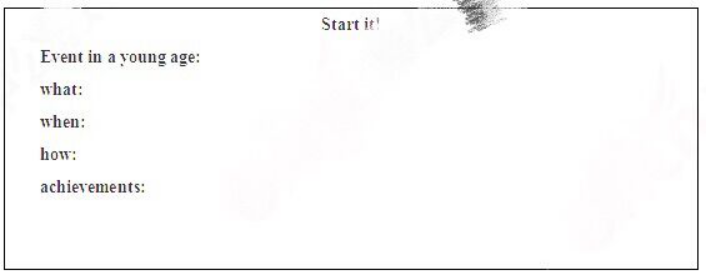
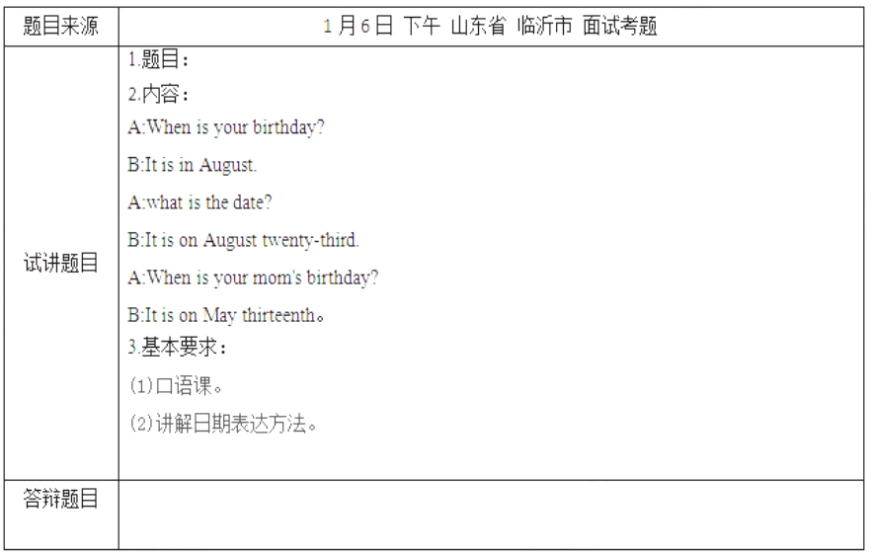
本题解析:
【教案】
Teaching aims:
Knowledge aim:
Students will master the expression of date and the sentence structure: -What is ...’s birthday? -It is ...
Ability aim:
Students will improve their abilities of speaking and listening.
Emotional aim:
Students will be more confident in speaking English.
Key and difficult point:
Key Point: Students will master how to express a date in English.
Difficult Point: Students will use the sentence structure in daily life.
Teaching procedure:
Step 1: Warming-up
1. Greetings.
2. Ask students if today is anyone’s birthday. And invite the whole class to sing a ‘Happy Birthday’ song to him or her.
Step 2: Pre-listening
1. Review the knowledge about ordinal numeral: write some numbers on the blackboard and ask students to change the cardinal numeral into ordinal numeral.
2. Ask students to look at the picture in the textbook to predict what the dialogue may be about.
Step 3: While-listening
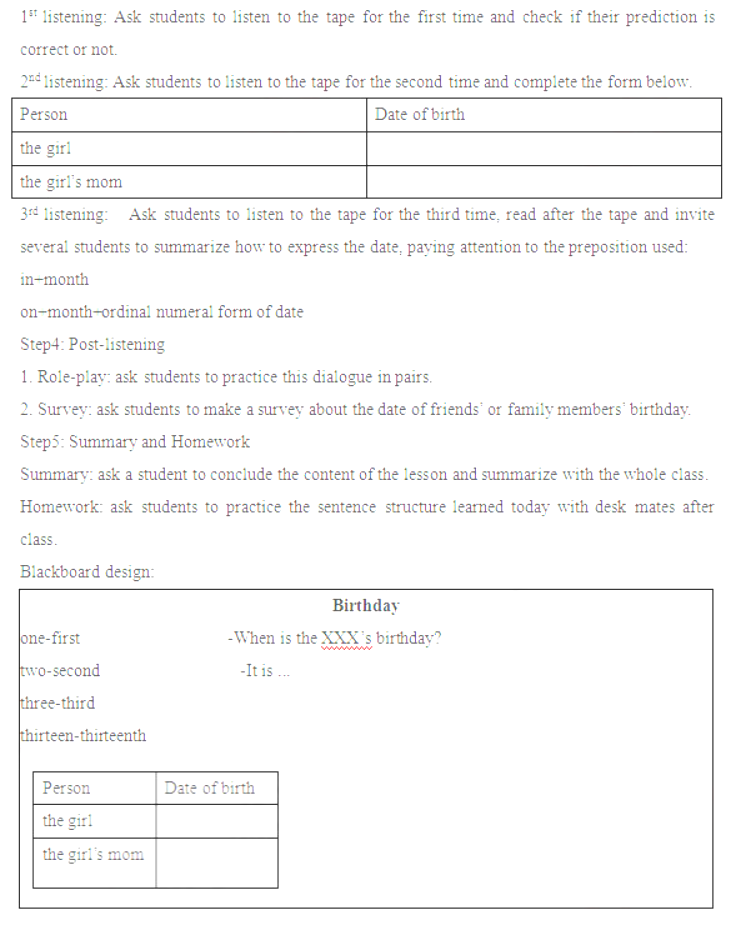
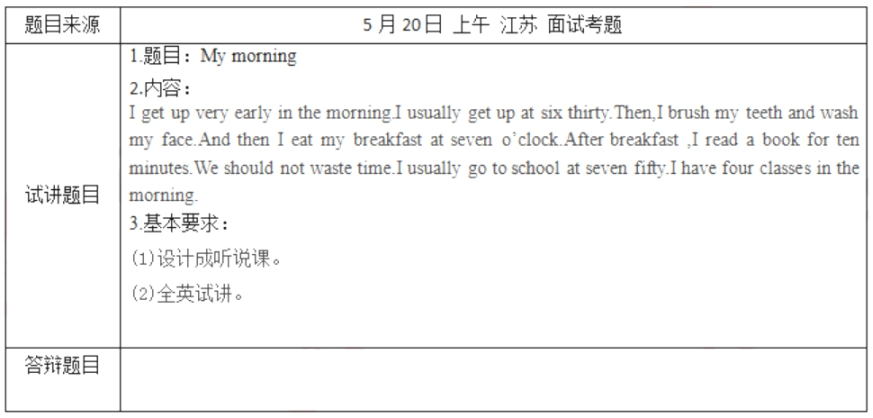
本题解析:
【教案】
Teaching aims:
Knowledge aims:
Students will know how to describe a day using proper conjunctions and tense.
Students will master some words, such as waste, value... and a sentence structure: I usually + simple present tense.
Ability aim:
Students will improve their abilities of speaking and listening.
Emotional aim:
Students will be more confident in speaking English.
Key and difficult point:
Key Point: Students will know how to introduce a day in English.
Difficult Point: Students will use the sentence structure in real communicative situation.
Teaching procedure:
Step 1: Warming-up
1. Greetings.
2. Play a video about Tom’s day and ask students what kind of information have they caught.
Step 2: Pre-listening
1. Review the knowledge about simple present tense. Ask students to make sentences using simple present tense.
2.Using pictures to explain some words: waste-value, brush.
Step 3: While-listening
1st listening: Ask students to listen to the tape for the first time and try to get the main idea of the passage and underline the conjunctions used.
2nd listening: Ask students to listen to the tape for the second time and complete the timetable below.
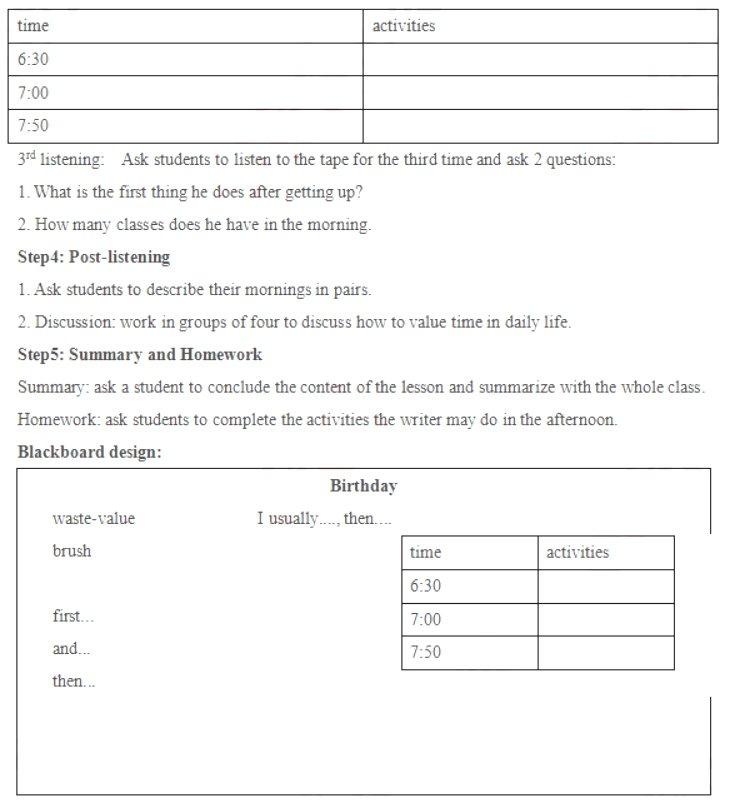
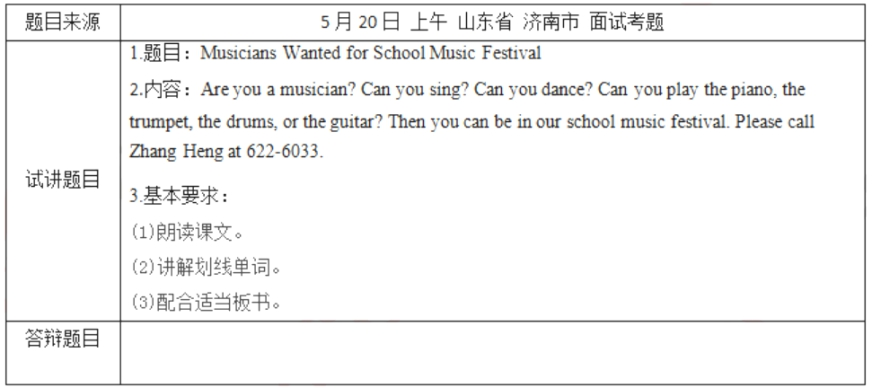
本题解析:
【教案】
Teaching aims:
Knowledge aim: Students will master the sentence pattern “can you” and some new words such as sing, play the piano and so on.
Ability aim: Students will improve their speaking ability through group work.
Emotional aim: Students will take part in the class actively and be fond of learning English.
Key and difficult point: Students can master the sentence pattern and words and can take part into the class actively.
Teaching procedure:
Step 1: Warming-up
Greeting: Good morning boys and girls, this is your beloved English teacher, Jessica. How are you today? Fine, I'm too. It is snowing right now right? The weather is getting colder and colder, so put on more clothes and don't catch cold ok? Otherwise you will lag behind for your English studying.
Lead-in: 展示有关音乐会的图片:Sydney Opera House/ National opera house in Beijing
1)what can you see in the pictures
2) Where can we do in it?
3) Do you like to enjoy a music show in our school?
4) Let’s take a look of today’s class: musicians wanted for school music festival.
Step 2: Pre-reading
图片讲解单词:sing/ dance/ play the piano/
1) What can you see in the pictures: 依次展示TF boys/ ballet/ 朗朗
2) What is he/ she doing in the picture? 依次引出: sing/ dance/ play the piano.
3) When you sing, you make musical sounds with your voice, usually producing words that fit a tune.
4) When you dance, you move your body and feet in a way that follows a rhythm, usually in time to music.
5) A piano is a large musical instrument with a row of black and white keys. When you press these keys with your fingers, little hammers hit wire strings inside the piano, which vibrate to produce musical notes.
Step 3: While-reading
设置阅读问题:
1) Which musical instruments are mentioned in the passage:
The piano (Y), the trumpet (Y), the drums (Y). violin (X).
2) who should you contact if you are interested: zhang heng
3) The telephone number? 622-6033.
Step4: Post-reading
1) Do a survey: which musical instruments can your classmate play?
2) Making a conversation by using the result of the survey: Do you want to go to the music festival?

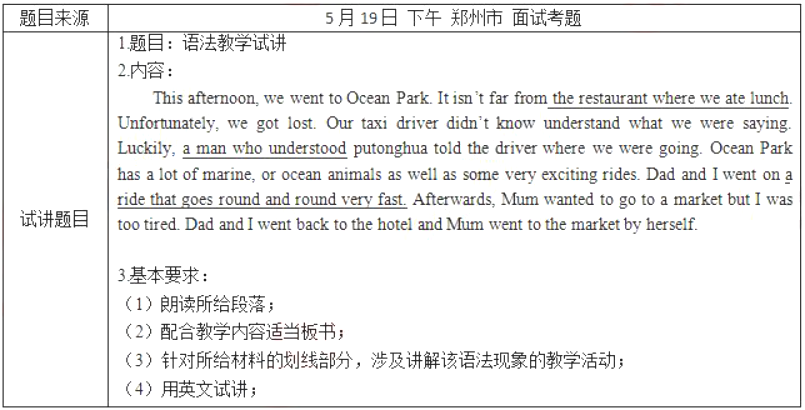
本题解析:
【教案】
Teaching Aims:
Knowledge aim: Students will master the structure of attributive Clause and understand what the relative words or antecedents are.
Ability aim: Students can use the attributive clause to describe what happened in their daily life and make up more superior sentences.
Emotional aim: Students will be inspired to study both English and putonghua very well so that they can solve problems they will meet abroad by themselves.
Teaching Key Points:
Students acquire the clause structure and know the relative words as well as antecedents.
Teaching Difficult Points:
Students can apply the structure into daily communication and get the difference between relative pronoun and adverb.
Teaching Methods:题目来源于考生回忆
Communicative teaching method, task-based teaching method, situational teaching method.
Teaching Aids:
PPT, Blackboard and so on
Teaching Procedures:
Step 1: Warming up
1.Greetings
2.Review: Show students two sentences. One is an adverbial clause of place that linked by where and the other is an attributive clause that also linked by where Where there is a will there is a way. Let them find out the differences or similarities between them and lead to what we’re going to learn today.
Step 2: Presentation
1. Read the passage briefly and and answer 3 questions. Where is the Ocean park? Who helped us? How was the ride? To lead the three underlined parts Then write down the three sentences students choose from the passage after reading.
2.Explain the common parts of these three sentences and show the structure of attributive clause.
3.Tell students that when the antecedent is a person or an object, we should choose different relative words. Also, they should understand the difference between attributive clause linked by where and the adverbial clause of place linked by where.题目来源于考生回忆
Step 3: Practice
1. Give them some sentences with blankets and let them choose the proper relative words.
2. Show them several clauses and find out which are attributive clauses.
Step 4: Production
Discussion and share: students work in pairs to describe their travel by using attributive clauses; teacher will give them 5 minutes to prepare it and 5 minutes later, invite some students to share their experiences.
Step 5: Summary & Homework
Summary : students look at the blackboard and summarize this class.
Homework:students find more rules about attributive clauses and prepare for the next class.
Blackboard design:
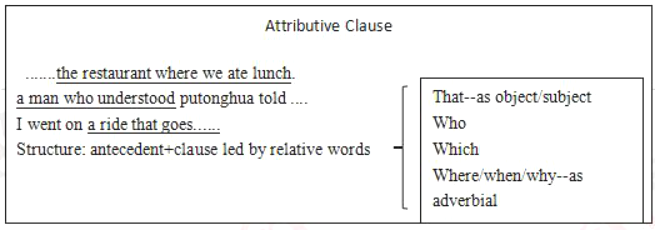
试卷分类:中学语文学科知识与教学能力
练习次数:1次
试卷分类:中学语文学科知识与教学能力
练习次数:1次
试卷分类:中学语文学科知识与教学能力
练习次数:0次
试卷分类:中学音乐学科知识与教学能力
练习次数:0次
试卷分类:中学信息技术学科知识与教学能力
练习次数:0次
试卷分类:中学信息技术学科知识与教学能力
练习次数:1次
试卷分类:中学物理学科知识与教学能力
练习次数:6次
试卷分类:中学体育学科知识与教学能力
练习次数:5次
试卷分类:中学思想品德学科知识与教学能力
练习次数:5次
试卷分类:中学思想品德学科知识与教学能力
练习次数:5次